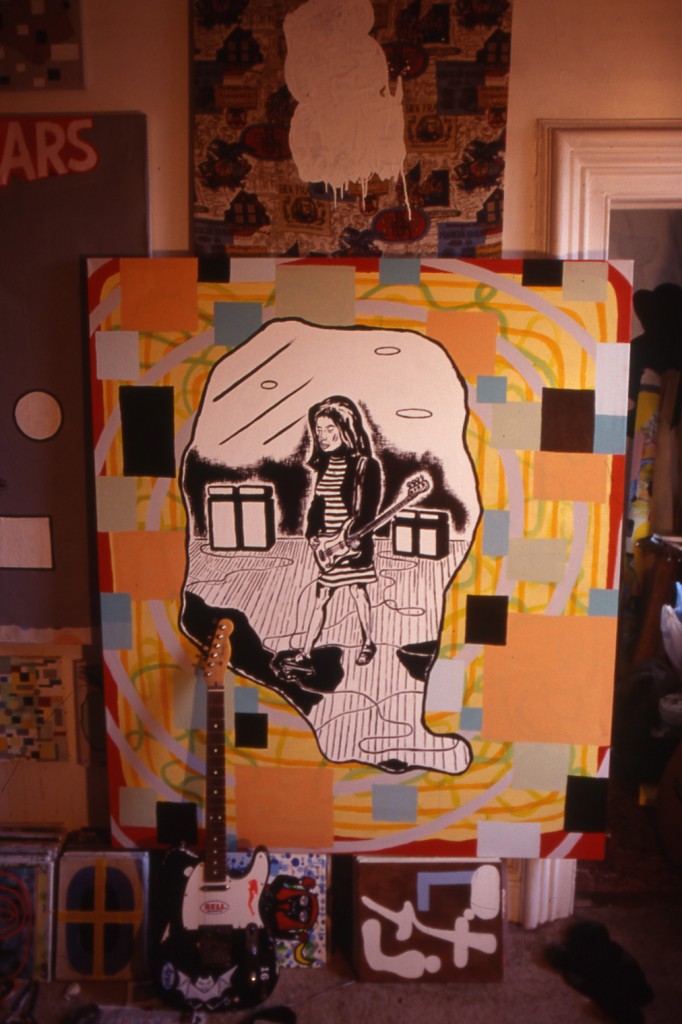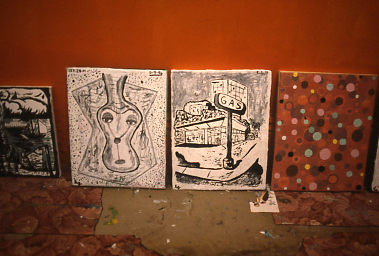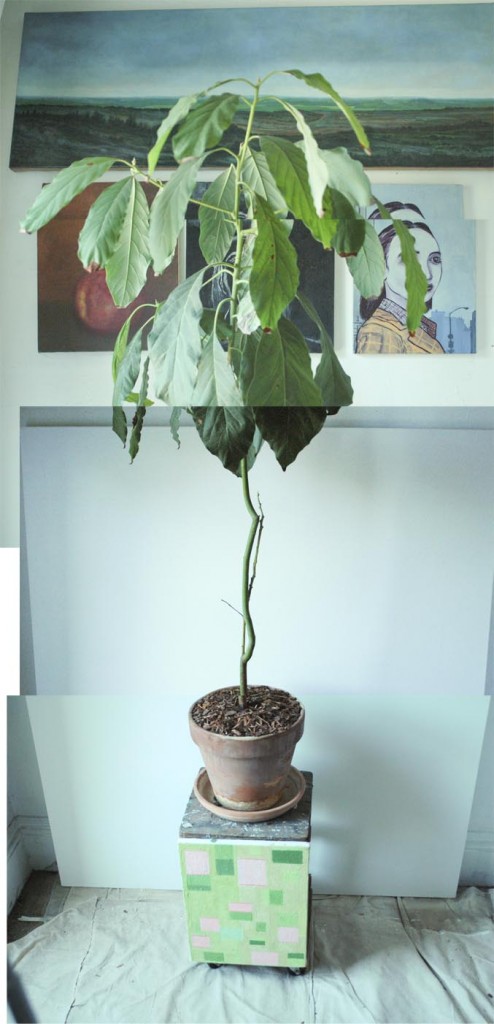
Here’s a shot from several years ago of the studio floor with my guitar and some of my “Enigromatic” paintings, all piled up in stacks on the floor or hanging “salon style” on the wall. At the time I was playing the guitar quite a lot and the instrument came to symbolize for me a certain kind of “energy” that I think is necessary to the creative process.
I’m using the term “energy” here because it points to something, in this context anyway, that I think is important for anyone who undertakes a creative activity, whether it is in music or painting, poetry, drama, or anything else. I don’t really have a particular name for that energy; people from various cultures have depicted it in various ways, it seems. The guitar is just one representation of it for me; it could just as easily be a flute or a flower, a paintbrush or a palette knife.
The big painting on top of all the little paintings is supposed to be a portrait of Kim Gordon, the bass player for the band called Sonic Youth, only I made her hair dark instead of blonde. It’s from a photograph that I saw in Spin magazine or Rolling Stone, one of those popular music review mags. The guitar has become a kind of masculine symbol in some ways, especially the electric guitar; so there’s a potential for an exciting mixture of energies when a woman gets on a stage and plays an electric guitar.
In another sense, the guitar is just a neutral object like any other; it’s “potential” to manifest as a symbol of creative power is really empty, that is to say, it does not exist in and of itself. It’s because of this empty quality that objects are able to become repositories of meaning, which gets back to one of my favorite phrases of Allen Ginsberg’s that I like to quote, “Art’s not empty if it shows it’s own emptiness.”
I’d also like to do a portrait of Tina Weymouth, the bass player for the Talking Heads. Her playing was such an important element to that band; she brought a certain kind of funkiness into the mix that would not have been there if someone else had been trying to do the same thing, I think.
* * *
Starting in 1992 I began a series of small paintings that were based directly on imagery in my personal sketchbooks. I carried these sketchbooks with me just about everywhere; I still do. Some of the paintings derived from my books are very abstract, almost “minimalist” in their imagery, and some are figurative. Many of them were painted in a single sitting, while others have been revised and worked over a period of months and even years. I often would use a deliberately quick way of rendering the image, in keeping with the spirit of the sketchbook: there’s a freshness and spontaneity to a quickly drawn sketch that often gets lost when someone tries to “translate” that “energy” into another medium, such as paint. So the small panels and the fast-drying acrylic paints were a kind of device for trying to find some of that freshness in the act of painting.

The first series of these small paintings were all 9″ x 12″; partly because that size stretcher bar was easily obtainable, but also because the proportions happened to match the size of the room that I was living in at the time. So the small paintings ended up becoming another personal symbol of sorts.
When I moved from Manhattan to Brooklyn in 1994, I had a larger room to work in. So I continued the 9″ x 12″ series but also “expanded” into a new series of 12″ x 15″ paintings, to match the proportions of my new space. These groups of paintings are something that I refer to collectively as “Enigromatica.”
An Enigma is something that is difficult to understand or explain with the rational, left-brain intellect; it can also refer to obscure manners of speech, writing, or cultural expression. “Roma” is a kind of shorthand for romanticism. According to the Oxford Dictionary of Art, Romanticism is something too varied in its manifestations to conform to a single definition, but its “keynote was a belief in the value of individual experience.” Intuition and instinct were important to the so-called Romantic artist.
“Enigromatica,” then, is an amalgamation of two related notions into a single blurb which stands for what I believe is the spirit of my own activity as an artist, or any creative person’s activity by extension. I didn’t entirely make this up myself, by the way, though maybe I’ve put my own little bit of spin on it. I first saw the phrase “ENIGROMA” on the cover of a notebook that another artist, David Dunlap had made, when I was studying painting and printmaking in Iowa City as a graduate student. That brings in another aspect of Enigromatica, which for me is the interdependence of the creative act with other creative activities that are going on: inspiration, in other words.
Our culture tends to emphasize the individual as the locus of creative genius, and I think there may be something important in that, but there is also the inspiration that one draws from the energy of others: we pay money to listen to popular musicians like Kim Gordon or Tina Weymouth because they inspire us. We go to school and study music or art because someone, such as a teacher or another artist, has inspired us with their own interactions with “creative energy”. I call this entire web of interrelated creative forces “The Enigromaticon.” It is the Great Web of creative power, a matrix of form and energy that forms the basis of everything in the universe.
* * *



